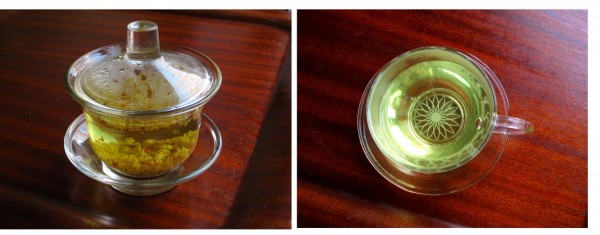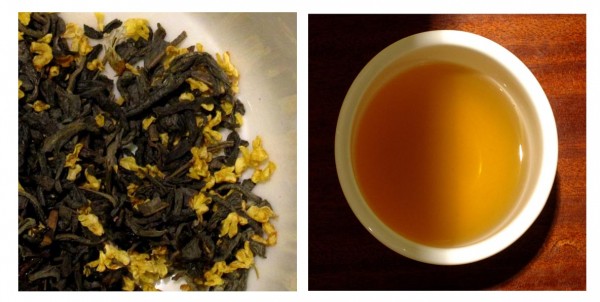Tea or Dessert?
Most of my tea friends know that I’m not a fan of flavoured teas, particularly teas with dessert names, such as “New York Cheesecake” or “Apple Crumble”, etc. These sweet themed teas are usually enhanced with artificial flavours or if the flavours are natural, the black or green tea base is inferior and anyway, most retailers don’t want to waste a premium tea by adding unnecessary enhancements. There are however traditional fragrances that have been infused into or added to tea leaves for centuries. Some aromatics may even have the ability to coax subtle flavours from a nuanced leaf. In this series I will examine some of the more customary additions such as Ginger, Jasmine and Osmanthus. We’ll first look at Osmanthus, an evergreen bush that produces sweet smelling clusters of flowers.

Aromatic Shrub
A common shrub used for landscaping in gardens throughout temperate zones, it flowers best on old wood. If pruned it will produce new vegetative growth rather than flowers.
The Osmanthus that is commonly used in the tea world is Osmanthus Asiaticus. In China it is known in pinyin as guìhuā chá 桂花茶. The dried Sweet Osmanthus flower is consumed alone as an herbal tisane that is believed to improve complexion. It may also be combined with black or green tea leaves to produce a perfumed tea. In Japan it is known as Gin-mokusei (orange Osmanthus) and is a favourite garden shrub. Also known as Sweet Olive, its small white flowers appear in short stalked clusters in late autumn. It has an intense sweet fragrance which has been described as a blend of gardenia and ripe apricots.
I obtained some dried Osmanthus flowers from Tao Tea Leaf, (so far, my best source in Toronto for fine quality Chinese tea.) When I opened the package, I was hit with a strong fruit smell – a cross between apricot and pineapple. I’m not familiar with gardenia fragrance, but some say that Osmanthus perfume is similar. The dried flowers were golden yellow and there were thousands of them. How many days did it take to pick them? Were they picked by hand? or machine? I’ll probably never know.

Observations
I decided to make a tisane from only the flowers first, before blending them with some tea leaves. I added boiling water to a heaping teaspoon and left them for a minute. The liquor smelled lovely – in fact I can still smell the wet flowers. The flavour was not as lovely, at least it was not what I expected. I thought it would be sweet, but it had an edge of bitterness.

I mixed some Osmanthus flowers with some generic green tea that I bought in NYC. (about a 1:6 ratio, flower to leaf). I prepared it as I would green tea and found the taste to be much improved over the Osmanthus flowers alone. The gentleness of the green tea tempered the florals, and the small amount of flower added only aroma and not bitterness.

Osmanthus has also become a popular ingredient in the luxury perfume industry eg. Ormonde Jayne Perfumery’s “Osmanthus Absolute”. Somewhere hidden away I had a vial of Hermes Osmanthe Yunnan Eau de Cologne, which I dug out, unstoppered and whiffed. I detected a strongly distilled essence of the scent which I perceived in the dried flowers, but blended with other fragrances. There is a species of Osmanthus called Yunnan and that may be what Hermes’ perfume title is referencing, but it certainly adds some exotica to the brand. Maybe that’s really all tea retailers are trying to do when they come up with tea names like “Strawberry Shortcake” or Chocolate Mousse” – just wanting to add some drool-inducing items to their line up of teas. Most retailers I speak to say that they’d be out of business if they didn’t offer the flavour-added teas. What has been your experience? Are there some flavour blends that you are certain will be the “traditionals” of the future?




